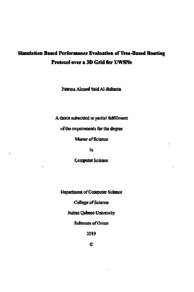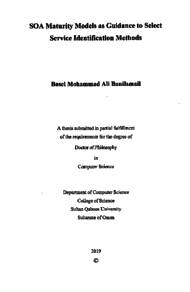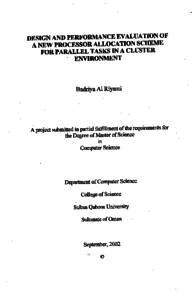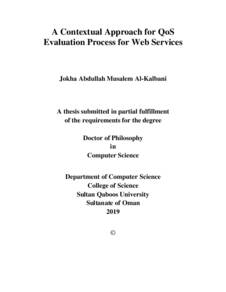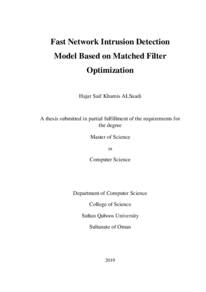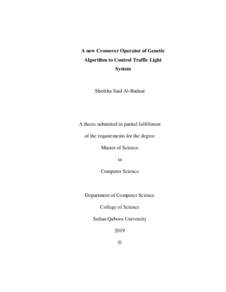Document
Simulation based performance evaluation of tree-based routing protocol over a 3D grid for UWSNs
Publisher
Sultan Qaboos University
Gregorian
2019
Language
English
Subject
English abstract
Underwater Wireless Sensor Networks (UWSNs) are promising for discovering the aqueous environment. They have attracted the interest of many researchers in the last decade. UWSNs are used for military and non-military applications such as undersea exploration of natural resources, tactical supervision, and mines detection. Several research problems related to UWSNs have been tackled. In particular, routing is a challenging problem in UWSNs. Routing protocols for UWSNS should take into consideration several constraints related to the difficult underwater conditions including dynamic topology, limited energy, low bandwidth and high propagation delay of acoustic signals used for communication underwater. In [31] a new Tree-Based Routing protocol called TBR for Underwater Wireless Sensor Networks has been proposed. The protocol constructs shortest-path trees in a virtual 3D grid topology and uses them to obtain routing paths between sensor nodes and sink nodes in the UWSN. It has been claimed that due to the availability of these pre-constructed shortest-path trees, TBR is expected to outperform other protocols which rely on costly reactive mechanisms for path establishment and maintenance. The aim of this project is to confirm this expectation through implementing the TBR protocol over 3D grid for UWSN, evaluating its performance, and comparing it to the performance of other protocols using simulation. The performance measures: delivery ratio, communication delay, and energy consumption have been used in the performance evaluation. The evaluation was conducted by varying the network parameters: density, mobility and load.
The simulation was conducted using Aqua-Sim which is a network simulator for underwater sensor networks. Aqua-Sim is based on NS-2, one of the most widely used network simulators. The obtained results show that TBR outperforms the well-known Vector-Based Forwarding (VBF) routing protocol for UWSNs in terms of packet delivery ratio and average end to end delay. TBR has performed more than two times better than VBF in terms of these two metrics. However, TBR consumed considerably more energy than VBF (up to ten times more in some of the tested cases). It was also observed from the simulations that TBR performs better under lower mobility speeds of the sensor nodes.
Member of
Resource URL
Arabic abstract
شبكات الاستشعار اللاسلكية تحت الماء واعدة لاكتشاف البيئة المائية. لقد جذبت اهتمام العديد من الباحثين في العقد الماضي. يتم استخدام شبكات الاستشعار اللاسلكية تحت الماء التطبيقات العسكرية وغير العسكرية مثل استكشاف الموارد الطبيعية، والإشراف التكتيكي، والكشف عن الألغام. تمت معالجة العديد من مشاكل البحث المتعلقة في شبكات الاستشعار اللاسلكية تحت الماء. يعد موضوع توجيه البيانات مشكلة صعبة في شبكات الاستشعار اللاسلكية تحت الماء. بروتوكولات التوجيه يجب أن تأخذ في الاعتبار عدة قيود تتعلق بالظروف الصعبة تحت الماء بما في ذلك ديناميكية الشبكة، والطاقة المحدودة، وعرض النطاق الترددي المنخفض، والمدة الزمنية الطويلة نسبيا لانتشار الإشارات الصوتية المستخدمة للاتصالات تحت الماء. تم مؤخرة اقتراح بروتوكول توجيه جديد يسمی تببر قانم على هياكل شجرية لشبكات الاستشعار اللاسلكية. ينشئ البروتوكول هياكل شجرية ذات المسارات الأقصر في شبكة افتراضية ثلاثية الأبعاد. يتم استخدام هذه الهياكل للحصول على مسارات توجيه بين أجهزة الاستشعار والجهاز المستقبل في شبكات الاستشعار اللاسلكية تحت الماء. وقد تم الافتراض بأنه نظرا لتوفر هياكل شجرية ذات مسارات قصيرة سابقة الإنشاء، من المتوقع أن يتفوق البروتوكول المقترح على البروتوكولات الأخرى التي تعتمد على آليات تفاعلية مكلفة لإنشاء مسارات وصيانتها. يهدف هذا المشروع إلى تأكيد هذا التوقع من خلال برمجة البروتوكول المقترح في شبكة لاسلكية ثلاثية الأبعاد للاستشعار تحت الماء، وتقييم أدائه، ومقارنته بأداء بروتوكولات أخرى باستخدام المحاكاة. تم استخدام المقاييس التالية لتقييم الأداء: نسبة التسليم، والمدة الزمنية للتسلييم، وكمية الطاقة المستهلكة. أجري التقييم من خلال التحكم في المتغيرات التالية للشبكة: عدد أجهزة الاستشعار وسرعة تنقل أجهزة الاستشعار وحمل الشبكة (كمية البيانات الموجهة).
أجريت المحاكاة باستخدام نظام اكواسيم وهو محاكي لشبكات الاستشعار تحت الماء. اكواسيم يعتمد على نظام ان. اس.2، وهو واحد من أكثر محاكيات الشبكات استخداما. أظهرت النتائج التي تم الحصول عليها تفوق البروتوكول المقترح على بروتوكول التوجيه المعروفه ف.ب. ف لشبكات الاستشعار اللاسلكية تحت الماء من حيث نسبة التسليم ومتوسط المدة الزمنية للتسلييم. لقد كان أداء تبر أكثر من مرتين أفضل من ف.ب. ف من حيث هذين المقياسين. وفي المقابل، استهلك ت. ب.ر طاقة أكبر بكثير من ف.ب. ف (ما يصل إلى عشرة أضعاف في بعض الحالات التي تم اختبارها). وقد لوحظ أيضا من عمليات المحاكاة أن أداء تب بر أفضل في حالات السرعات المنخفضة لتنقل أجهزة الاستشعار.
أجريت المحاكاة باستخدام نظام اكواسيم وهو محاكي لشبكات الاستشعار تحت الماء. اكواسيم يعتمد على نظام ان. اس.2، وهو واحد من أكثر محاكيات الشبكات استخداما. أظهرت النتائج التي تم الحصول عليها تفوق البروتوكول المقترح على بروتوكول التوجيه المعروفه ف.ب. ف لشبكات الاستشعار اللاسلكية تحت الماء من حيث نسبة التسليم ومتوسط المدة الزمنية للتسلييم. لقد كان أداء تبر أكثر من مرتين أفضل من ف.ب. ف من حيث هذين المقياسين. وفي المقابل، استهلك ت. ب.ر طاقة أكبر بكثير من ف.ب. ف (ما يصل إلى عشرة أضعاف في بعض الحالات التي تم اختبارها). وقد لوحظ أيضا من عمليات المحاكاة أن أداء تب بر أفضل في حالات السرعات المنخفضة لتنقل أجهزة الاستشعار.
Category
Theses and Dissertations

